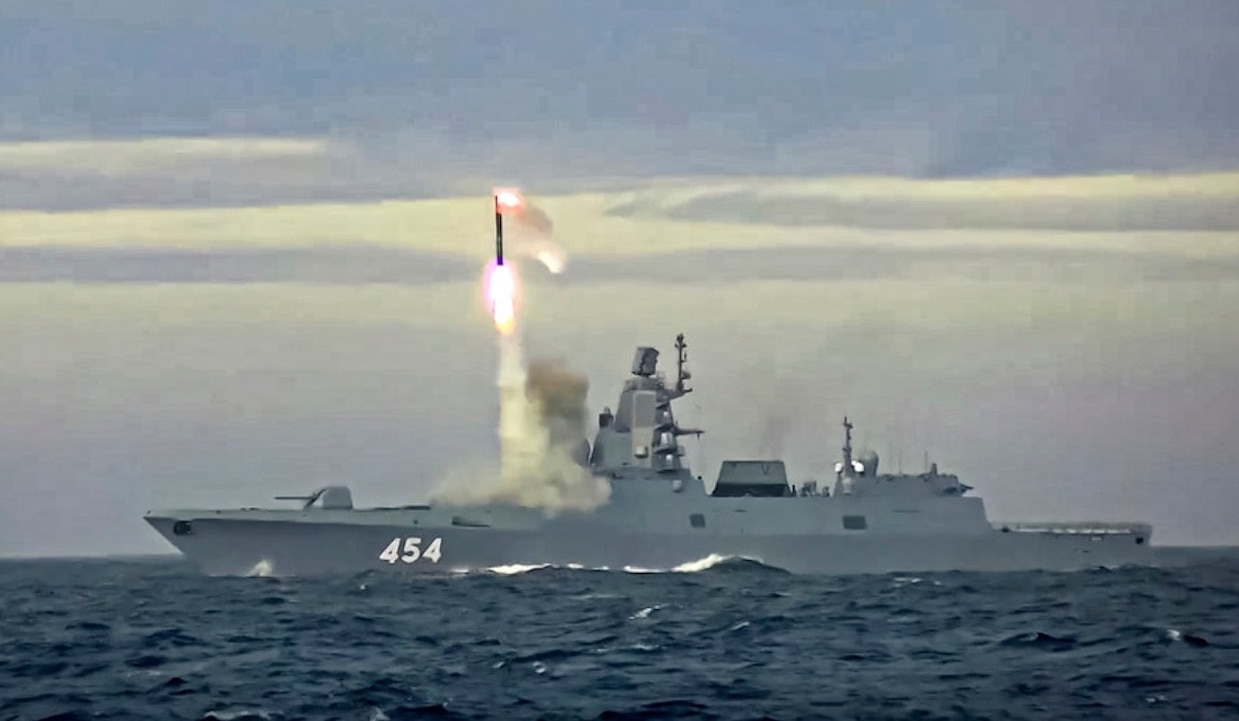Terrible Nuclear Zircon Missile in the Mediterranean Sea. Russian Frigate Admiral Gorshkov in Tartus Harbor

UPDATES
April 22
A group of four warships passed Europa Point at the Strait of Gibraltar and headed towards the Atlantic Ocean. These vessels were visually identified as the frigate Admiral Grigorovich, the Steregushchy class corvettes Stoiky and Soobrazitelny [1] as well as the fleet oiler Kama [2].
Satellite imagery of the port of Tartus showed several Russian warships inside the harbor. These were identified as the Improved Kilo class submarine Krasnodar, the Buyan-M class corvette Orekhovo-Zuyevo, the Aleksandrit class minehunter Vladimir Emelyanov, the fleet oiler Kola and the intelligence collection vessel Yuri Ivanov [3].
April 25
Satellite imagery of the port of Tartus showed at least three vessels present inside the port. These were identified as the frigate Admiral Gorshkov, the Buyan-M class corvette Orekhovo-Zuyevo and the fleet oiler Kola [4]. Bad resolution and overcast clouds did not allow to verify if other vessels were present inside the port. (source Russian Navy – News and Analysis)
by Fabio Giuseppe Carlo Carisio
On Aprile, 11, in the afternoon, the frigate Admiral Gorshkov (454) and the tanker Kama entered the Mediterranean via the Suez Canal, according to Itamilradar.
After about four months of travel (the two units left the Russian port of Murmansk at the beginning of January) and several stops (notably in South Africa to participate in an exercise with the South African and Chinese navies, and in Iran), the arrival of the pair of ships in Tartus, Syria, is expected today.
The entry of the Russian frigate would not by itself be a particularly destabilizing element of the situation, if it were not for the fact that the ship is armed with hypersonic missiles.

«Recently, Russia has developed hypersonic missiles, which have become a topic of concern for the global community. Hypersonic missiles are the ones that travel at a speed of more than five times the speed of sound, making them incredibly difficult to intercept» Itamilradar wrote.
Some of the Russian hypersonic missiles include the Kinzhal missile, which is launched from a fighter jet, and the Zircon missile, which is a submarine-launched missile.
It can carry a warhead of 300 HE (High Explosive), >200 kt tnw (tactical nuclear weapon) nuclear. The maximum firing range is around 1.500 km or 930 mi.
At the moment it is impossible to know the intentions of the Russian Navy regarding the use of the Admiral Gorshkov frigate.
And, therefore, whether she will remain in the Mediterranean Sea for a long time as a threat to the NATO countries that are helping Kiev fight a war it would have already lost without the armaments of EU and US nations.
Or if she instead she will be deployed in the Black Sea to be closer to the theater of conflict.
The Powerful Zircon Missile
The Zircon, first produced in 2016, is an anti-ship missile capable of accelerating up to Mach 9. It has been designed to hit enemy surface ships, such as frigates and aircraft carriers, as well as ground targets located within the range of the missile.
Zircon’s speed (9,800-11,025 km/h) makes it difficult for it to be stopped by any anti-aircraft systems. While this latest launch is the first time the missile has been fired from a nuclear submarine, it has already undergone testing from surface carriers.
This has led to concerns that it could penetrate existing naval defense systems. Because it flies at hypersonic speeds within the atmosphere, air pressure in front of it forms a plasma cloud as it moves, absorbing radio waves and making it practically invisible to active radar systems (plasma stealth).
However, this also blinds any radar or IR seeker on the missile. With plasma stealth, hypersonic-speed and sea skimming technique, intercepting a flying Zircon is extremely difficult, if at all feasible at the current level of technology.
The final section of the trajectory is completed in minimal time (under 10 seconds), so the enemy will likely not have time to carry out all the necessary procedures to intercept it. Zircon exchanges information in flight and can be controlled by commands if necessary.
In August, Admiral Charles A. Richard of the US Navy warned that hypersonic missiles being created by both Moscow and Beijing pose a significant threat to America. “Because of these challenges, our current terrestrial- and space-based sensor architecture may not be sufficient to detect and track these hypersonic missiles,” he said.
Earlier this year, as part of his annual address to the Federal Assembly, Russian President Vladimir Putin revealed that the country’s armed forces are modernizing quickly with “hypersonic and laser” missiles, and warned foreign adversaries not to cross Moscow’s “red lines.”
Alert in Italy for the Impressive Increase of the Russian Fleet
The war in Ukraine has repercussions on Italy’s security. The Mediterranean has an increasingly strategic role.
«The immediate effects on our security of the war in Ukraine have reverberated once again on the sea and are the impressive increase in the numbers of the Russian fleet in the Mediterranean and Black Seas to a level not seen even in the times of the Cold War» underlined the Chief of Staff of the Navy, Enrico Credendino, in a hearing before the Defense Commission of the Chamber on February.
«The number of Russian ships in the Mediterranean – he continued – has increased, a high number which is not a direct threat to the national territory but increases tension greatly. The Russians have an aggressive attitude which was not usual in the Mediterranean and was previously only evident in the Baltic. The risk of an accident is possible and when there is an accident of this nature you never know where it could end up».
«Satellite imagery of the port of Tartus showed several warships being moored inside the harbor. These vessels were identified as the Improved Kilo class submarine Krasnodar, both Steregushchy class corvettes and the Altay class fleet oiler Kola» reported the blog of Lieutenant Van Lokeren served for 7 years as an officer within the Belgian Navy.
Grisha class anti-submarine warships Snezhnogorsk and Brest departed the Kola and will hold anti-submarine exercises in the Barents Sea. Both vessels were escorted by the Sonya class minesweepers minesweepers Yadrin and Solovki Yunga who provided protection against sea mines during the transit. Both anti-submarine vessels will train together with nuclear submarines of the Northern Fleet and anti-submarine naval aviation.
Naval aviation in the form of Tu-142 patrol aircraft and Ka-27M anti-submarine helicopters were deployed to joint the same exercise.
Fabio Giuseppe Carlo Carisio
© COPYRIGHT GOSPA NEWS
prohibition of reproduction without authorization
follow Gospa News on Telegram




Un pensiero su “Terrible Nuclear Zircon Missile in the Mediterranean Sea. Russian Frigate Admiral Gorshkov in Tartus Harbor”